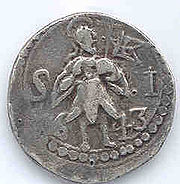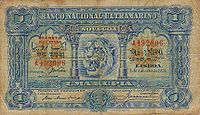
Portuguese Indian rupia
Encyclopedia

The rupia was the currency of Portuguese India
Portuguese India
The Portuguese Viceroyalty of India , later the Portuguese State of India , was the aggregate of Portugal's colonial holdings in India.The government started in 1505, six years after the discovery of a sea route to India by Vasco da Gama, with the nomination of the first Viceroy Francisco de...
until 1958.
History
Before 1871, the rupia was subdivided into 750 bazarucos, 600 réis (singular: real), 20 pardaus or 10 tangas, with the xerafim worth 2 rupias. After 1871, 960 réis or 16 tangas (worth 60 réis) equalled 1 rupia. The rupia was equal in value to the Indian rupeeIndian rupee
The Indian rupee is the official currency of the Republic of India. The issuance of the currency is controlled by the Reserve Bank of India....
. This meant the tanga was equal in value to the Indian anna
Indian anna
An Anna was a currency unit formerly used in India, equal to 1/16 rupee. It was subdivided into 4 Paise or 12 Pies . The term belonged to the Muslim monetary system...
. In 1958, the currency was replaced by the escudo
Portuguese Indian escudo
The escudo was the currency of Portuguese India between 1958 and 1961. It was divisible into 100 centavos and was equal in value to the Portuguese escudo.-History:The escudo replaced the rúpia at the rate of 1 rúpia = 6 escudos...
at the rate of 1 rupia = 6 escudos.
Coins

Goa
Goa , a former Portuguese colony, is India's smallest state by area and the fourth smallest by population. Located in South West India in the region known as the Konkan, it is bounded by the state of Maharashtra to the north, and by Karnataka to the east and south, while the Arabian Sea forms its...
, Damão
Daman District, India
Daman district is one of the two districts of the union territory of Daman and Diu on the western coast of India, surrounded by Valsad District of Gujarat state on the north, east and south and the Arabian Sea to the west. The district has an area of , and a population of 113,949 , which increased...
and Diu issued their own coinages until the middle of the 19th century. Damão issued copper
Copper
Copper is a chemical element with the symbol Cu and atomic number 29. It is a ductile metal with very high thermal and electrical conductivity. Pure copper is soft and malleable; an exposed surface has a reddish-orange tarnish...
3, 15, 30 and 60 réis coins until 1854 when the mint closed. Diu issued lead
Lead
Lead is a main-group element in the carbon group with the symbol Pb and atomic number 82. Lead is a soft, malleable poor metal. It is also counted as one of the heavy metals. Metallic lead has a bluish-white color after being freshly cut, but it soon tarnishes to a dull grayish color when exposed...
and tin
Tin
Tin is a chemical element with the symbol Sn and atomic number 50. It is a main group metal in group 14 of the periodic table. Tin shows chemical similarity to both neighboring group 14 elements, germanium and lead and has two possible oxidation states, +2 and the slightly more stable +4...
5 and 10 bazarucos together with tin 20 bazarucos, copper 30 and 60 réis and silver
Silver
Silver is a metallic chemical element with the chemical symbol Ag and atomic number 47. A soft, white, lustrous transition metal, it has the highest electrical conductivity of any element and the highest thermal conductivity of any metal...
150 and 300 réis and 1 rupia. The Diu mint closed in 1859.
Goa
Goa
Goa , a former Portuguese colony, is India's smallest state by area and the fourth smallest by population. Located in South West India in the region known as the Konkan, it is bounded by the state of Maharashtra to the north, and by Karnataka to the east and south, while the Arabian Sea forms its...
issued the most diverse coinage of the three mints. In addition to tin bastardo, there were copper coins in denominations of 3, 4½, 6, 7½, 9, 10, 12 and 15 réis, ½ and 1 tanga, silver coins for ½ and 1 tanga, ½ and 1 pardau, and 1 rupia, and gold
Gold
Gold is a chemical element with the symbol Au and an atomic number of 79. Gold is a dense, soft, shiny, malleable and ductile metal. Pure gold has a bright yellow color and luster traditionally considered attractive, which it maintains without oxidizing in air or water. Chemically, gold is a...
1, 2, 4, 8 and 12 xerafins. The Goa mint was closed by the British in 1869.
Following the closure of the last local mint, coins were imported from Portugal beginning in 1871. This new coinage coincided with the reform of the subdivisions of the rupia. Copper coins were introduced in denominations of 3, 5, 10 and 15 réis, ½ and 1 tanga. In 1881, copper ⅛ tanga and silver ⅛, ¼, ½ and 1 rupia coins were introduced. Bronze replaced copper in 1901, whilst cupro-nickel 2 and 4 tangas were introduced in 1934, followed by ½ and 1 rupia in 1947 and 1952, respectively.
Banknotes

In 1906, the Banco Nacional Ultramarino
Banco Nacional Ultramarino
Banco Nacional Ultramarino was a Portuguese bank with operations throughout the world, especially in Portugal's former overseas provinces. It ceased existence as an independent legal entity in Portugal following its merger with Caixa Geral de Depósitos, the government-owned savings bank, in...
took over the issuance of paper money, issuing notes for 5, 10, 20 and 50 rupias. In 1917, notes were added for 4 and 8 tangas, 1 and 2½ rupias. These were the only issue of tanga denominated notes, whilst the 2½ rupia notes were issued until 1924 and the 1 rupia until 1929. 100 and 500 rupias notes were reintroduced in 1924.

